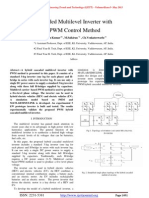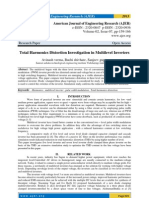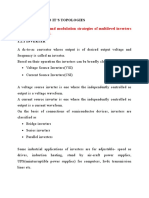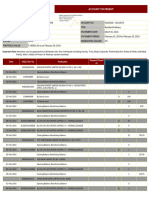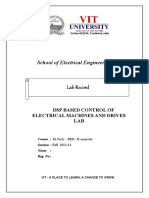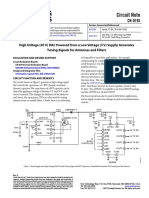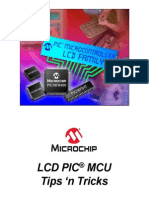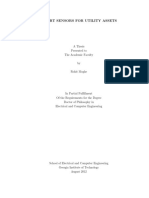A New Hybrid Cascaded H-Bridge Multilevel Inverter - Performance Analysis
A New Hybrid Cascaded H-Bridge Multilevel Inverter - Performance Analysis
Uploaded by
Gaurav BhandariCopyright:
Available Formats
A New Hybrid Cascaded H-Bridge Multilevel Inverter - Performance Analysis
A New Hybrid Cascaded H-Bridge Multilevel Inverter - Performance Analysis
Uploaded by
Gaurav BhandariOriginal Title
Copyright
Available Formats
Share this document
Did you find this document useful?
Is this content inappropriate?
Copyright:
Available Formats
A New Hybrid Cascaded H-Bridge Multilevel Inverter - Performance Analysis
A New Hybrid Cascaded H-Bridge Multilevel Inverter - Performance Analysis
Uploaded by
Gaurav BhandariCopyright:
Available Formats
IEEE- International Conference On Advances In Engineering, Science And Management (lCAESM -2012) March 30, 31, 2012
A New Hybrid Cascaded H-Bridge Multilevel
Inverter - Performance Analysis
ISujitha.N and 2Ramani.K
l.P.G. Scholar, 2. Faculty of Electrical and Electronics Engineering,
K.S.Rangasamy College of Technology, Thiruchengode-637215.
Email ID: sujitha.natarajan@gmail.com
Abstract-Cascaded
H-Bridge
multilevel
inverters
synthesize a medium voltage output based on a series
connection of power cells which use standard low
voltage component configurations. This characteristic
allows one to achieve high-quality output voltages and
input currents and also outstanding availability due to
their intrinsic component redundancy. Due to these
features,
the cascaded multilevel inverter has been
recognized as an important alternative in the medium
voltage inverter market. This paper presents a cascaded
H-bridge multilevel boost inverter for electric vehicle
(EV) and hybrid EV (HEV) applications implemented
without the use of inductors. Traditionally, each H
bridge needs a dc power supply. The proposed design
uses a standard three-leg inverter (one leg for each
phase) and an H-bridge in series with each inverter leg
which uses a capacitor as the dc power source. The
Hybrid
Cascaded
H-Bridge
Multilevel
inverter
is
implemented using the Selective Harmonic Elimination
PWM (SHEPWM) technique. The proposed topology
offers an intuitive method for minimizing the total
harmonic distortion (THD) of the output voltage of the
inverter which has been verified using the MATLAB
simulation. A fundamental switching scheme is used to
do modulation control and to produce a five-level phase
voltage.
Keywords:
inverter,
Selective
Cascaded
AC
Drive,
Harmonic
Hybrid
Total
H-bridge
Harmonic
Elimination
multilevel
Distortion,
pulse
width
Modulation (SHEPWM).
I. INTRODUCTION
Numerous industrial applications have begun to
require higher power apparatus in recent years. Some
medium voltage motor drives and utility applications
require medium voltage and megawatt power level.
For a medium voltage grid, it is troublesome to
connect only one power semiconductor switch
directly. The application of ac variable frequency
speed regulations are widely popularised, high power
and medium voltage inverter has known there are
many problems in conventional two level inverter in
the high power recently become a research focus so
far as application[3]. Multilevel voltage-source
inverters provide a cost effective solution in the
medium-voltage energy management market. These
converters have been widely applied to chemical, oil,
and Liquefied Natural Gas (LNG) plants, water
plants, marine propulsion, power generation, energy
transmIssIOn, and power quality devices [4].
Nowadays, there exist three commercial topologies of
multilevel voltage source inverters: Neutral Point
Clamped (NPC) [5], Cascaded H-Bridge (CHB) [4],
and Flying Capacitors (FCs) [6]. Among these
inverter topologies, Cascaded Multilevel Inverter
reaches the higher output voltage and power levels
(13.8 kV, 30 MVA) and the higher reliability due to
its modular topology. Cascaded H-Bridge multilevel
inverters are based on a series connection of several
single-phase inverters. This structure is capable of
reaching medium output voltage levels using only
standard low-voltage mature technology components.
Typically, it is necessary to connect three to ten H
Bridge inverters in series to reach the required output
voltage. These converters also feature a high
modularity degree because each inverter can be seen
as a module with similar circuit topology, control
structure, and modulation [7].
Both REVs and EVs need a traction motor and a
power inverter to drive the traction motor. The
requirements for the power inverter include high peak
power and low continuous power rating. Currently
available power inverter systems for REVs use a dc
dc boost converter to boost the battery voltage for a
traditional three-phase inverter. The dc-dc boost
converter is not required when the motor is running at
low to medium power, and the battery voltage will be
directly applied to the inverter to drive the traction
motor. the motor is running in a high power mode,
The dc-dc boost converter will boost the battery
voltage to a higher voltage when the motor is running
in a high power mode, so that the inverter can
provide higher power to the motor.
A cascaded H-bridge multilevel inverter for EV
and HEV applications is described in this paper.
Traditionally, each H-bridge of a cascaded multilevel
inverter needs a dc power supply. The proposed
cascaded H-bridge multilevel boost inverter uses a
standard three-leg inverter (one leg for each phase)
ISBN: 978-81-909042-2-3 2012 IEEE
46
47
IEEE- International Conference On Advances In Engineering, Science And Management (lCAESM -2012) March 30, 31, 2012
and an H-bridge in series with each inverter leg
which uses a capacitor as the dc power source [12]
[15]. In this topology, the need for large inductor is
eliminated. A fundamental switching scheme is used
to do modulation control and to output five-level
phase voltages.
This scheme does not require any modification
in the carrier or modulating signal. It has advantage
or superiority over other previous works. The
modeling of in this paper highlights the significance
of Five- level Hybrid Cascaded H-Bridge multilevel
inverter.
Output V H.1g<!
de21L---S_S
II. TOPOLOGIES OF MULTILEVEL INVERTER
A basic structure of a cascaded multilevel
inverter is shown in Fig. 1. Each inverter uses a dc
link voltage to generate a modulated voltage at the
output terminals. The total output voltage is obtained
by the sum of each individual output voltage. Each
inverter is able to produce three output voltage levels,
such as, +Vdc, -Vdc, and O. The maximum number of
voltage levels of the phase voltage Lph is given by
Lph = 2Ninv + 1
(1)
where Ninv is the number of inverters.
Fig. 2. Topology of the Single Phase Conventional Cascaded H
Bridge Multilevel Inverter
Each inverter requires an isolated dc voltage
which is usually obtained by an arrangement of three
phase or single-phase rectifiers [8], and a multipulse
transformer which provides the electrical isolation. In
some applications, these dc voltages can be obtained
directly by isolated dc sources, for example,
photovoltaic panels [10] or dc/dc isolated converters
[11]. In another application, like STATCOM, which
does not require the injection of active power, the dc
voltages can be floating, and the control strategy
keeps the dc-link voltage adjusted to the reference.
The topology of the proposed dc-ac Hybrid
cascaded H-bridge multilevel inverter is shown in
Fig. 3. The inverter uses a standard three-leg inverter,
one leg for each phase and an H-bridge with a
capacitor as its dc source in series with each phase
leg.
---'-_
----'
l:1
\dca2
)1 + Vdcb.:l.
/ + V&t1."'
ill
Va2
T . I "I
Vb2
To, I I
n
Fig. 1. Topology of the Three Phase conventional Cascaded H
bridge multilevel Inverter.
Fig.3. Topology of the proposed dc-ac Hybrid cascaded H-bridge
multilevel inverter.
ISBN: 978-81-909042-2-3 2012 IEEE
IEEE- International Conference On Advances In Engineering, Science And Management (lCAESM -2012) March 30, 31, 2012
48
voltage, so that during periods of zero voltage output,
either the switches SI, S4, and S6 are closed or the
switches S2, S3, and Ss are closed, depending on
whether it is necessary to charge or discharge the
capacitor. It is this flexibility in choosing how to
make that output voltage zero that is exploited to
regulate the capacitor voltage.
The goal of using fundamental frequency
switching modulation control is to output a five-level
voltage waveform, with a sinusoidal load current
waveform, as shown in Fig. 5(a). If the capacitor's
voltage is higher than Vde/2, switches Ss and S6 are
controlled to output voltage waveform VI, and the
switches SI, S2, S3, and S4 are controlled to output
voltage waveform V2, shown in Fig. 5(b). The
highlighted part of the waveform in Fig. 5(b) is the
capacitor discharging period, during which the
inverter's output voltage is 0 V.
Fig. 4. Single phase of the proposed dc-ac Hybrid cascaded H
bridge multilevel inverter.
Output Voltage
- -V=Vl+V2
A simplified single phase Hybrid cascaded H
Bridge multilevel inverter topology is shown in Fig.4.
The output voltage VI of this leg of the bottom
inverter (with respect to the ground) is either + Vdel2
(Ss closed) or -Vdel2 (S6 closed). This leg is
connected in series with a full H-bridge, which, in
turn, is supplied by a capacitor voltage. If the
capacitor is kept charged to Vde/2, then the output
voltage of the H-bridge can take on the values +Vde/2
(SI and S4 closed), 0 (SI and S2 closed or S3 and S4
closed), or -Vdel2 (S2 and S3 closed).
An example output waveform from this topology
is shown in Fig.5(a). When the output voltage V =VI
+ V2 is required to be zero, one can either set VI =
+Vdel2 and V2 = -Vdel2 or VI = -Vdel2 and V2 =
+Vde/2. Additional capacitor's voltage regulation
control detail is shown in Fig. 3. To explain how the
capacitor is kept charged, consider the interval 91 :S 9
:S n, the output voltage in Fig. 5(a) is zero, and the
current i > O. If SI and S4 are closed, so that V2 =
+Vde/2 and S6 is closed (so that VI = -Vde/2), then the
capacitor is discharging ie = -i < 0; see Fig. 5(b), and
V = VI + V2 = O. On the other hand, if S2 and S3 are
closed, so that V2 = -Vdel2 and Ss is also closed (so
that VI = +Vdel2), then the capacitor is charging ie = i
> 0; which is mentioned in Fig. 5(c), and V = VI + V2
= O. The case i < 0 is accomplished by simply
reversing the switch positions of the i > 0 case for
charging and discharging of the capacitor.
Consequently,
the
method
consists
of
monitoring the output current and the capacitor
ISBN: 978-81-909042-2-3 2012 IEEE
II/
(a)
49
IEEE- International Conference On Advances In Engineering, Science And Management (lCAESM -2012) March 30, 31, 2012
V2
r--
r---
---;;
2fT
9,
Vl
-
,------
2fT
9,
Fig. 5(c). The highlighted part of the waveform in
Fig. 5(c) is the capacitor charging period, when the
inverter's output voltage is 0 V. Therefore, the
capacitors' voltage can be regulated by alternating
the capacitor's charging and discharging control,
when the inverter output is 0 V.
This method of regulating the capacitor voltage
depends on the voltage and current not being in
phase. That is, one needs positive (or negative)
current when the voltage is passing through zero in
order to charge or discharge the capacitor.
Consequently, the amount of capacitor voltage the
scheme can regulate depends on the phase angle
difference of output voltage and current. In other
words, the highest output ac voltage of the inverter
depends on the displacement power factor of the
load.
TABLE I: SWlTCHING SEQUENCE OF CONVENTlONAL
METHOD
......
Interval
(b)
Vz
fT
9,
......
1fT
'---
ON Switches in
U-Bridge 1
ON Switches in UBridge 2
IT
S"S2
S5,S,
TIT
S"S2
S5,S6
IV
S"S2
S"S,
VI
S3,S.
S6,SS
VII
S3,S.
S"Ss
VIII
S3,S.
S6,SS
-
IX
V1
TABLE 2: SWlTCHING SEQUENCE OF PROPOSED
METHOD
Vdcl2 t--------..,
2fT
9,
ON Switches in HBridge
Interval
fT
(c)
Fig.5. Capacitor voltage regulation with capacitor charging and
discharging. (a) Overall output voltage and load current. (b)
Capacitor discharging.
(c) Capacitor charging.
The capacitor's voltage is lower than Vdc/2, the
switches S5 and S6 are controlled to output voltage
waveform VI, and switches SI, S2, S3, and S4 are
controlled to output voltage waveform V2, shown in
ON switch in three
phase full converter
11
S"S2
S,
TIT
S"S4
S5
IV
S"S2
S5
VI
S"S2
S6
V11
S2,S3
S6
VIII
S"S2
IX
S6
-
III. SIMULAnON RESULTS
ISBN: 978-81-909042-2-3 2012 IEEE
IEEE- International Conference On Advances In Engineering, Science And Management (lCAESM -2012) March 30, 31, 2012
The simulation result comprises of proposed
hybrid cascaded H-Bridge multilevel inverter and its
corresponding voltage waveform. The proposed
inverter is fed to a three phase induction motor and
its characteristics namely speed, torque is noted
down. The three phase voltage waveform with 120
degree phase shift for the five level hybrid cascaded
H-Bridge multilevel inverter is shown in Fig 7. The
speed characteristic is shown in Fig 8. The rated
speed for induction motor is 1430 rpm. Here the
speed curve shows that the motor attains its rated
speed after 4ms. The Torque characteristic is shown
in Fig 9. Initially high torque is attained and latter
settles to a constant value. The speed torque
characteristic is shown in Fig 10. As the speed
increases the torque settles to a constant value. In Fig
11, 12 the torque and speed curves for different
loading conditions are shown.
Q:[
Fig 6. Proposed Simulation Circuit
15 ..----.---r--r----.__-___._-____r
10
5
10
15 '-----'----'---L---'
o
0.01
0.02
0.03
0.04
0.05
0.06
0.07
0.(
TIme(ms)
Fig.7.0utput voltage waveform of a hybrid cascaded H-bridge
multilevel inverter
ISBN: 978-81-909042-2-3 2012 IEEE
50
You might also like
- H-Bridge 5 Level Inverter Using PWM TechniqueDocument31 pagesH-Bridge 5 Level Inverter Using PWM TechniqueKolan Vamshi Kiran Reddy100% (1)
- Base .7Document5 pagesBase .7மணிவேல் சந்திரன்No ratings yet
- 1 192 14446402801 4 PDFDocument4 pages1 192 14446402801 4 PDFbhaskaaNo ratings yet
- An Analysis and Survey of Multilevel Inverters Topologies, Controls, and ApplicationsDocument10 pagesAn Analysis and Survey of Multilevel Inverters Topologies, Controls, and ApplicationsDr-Ismayil CNo ratings yet
- A Novel Multilevel ACDCAC Single Phase To Three Phase Converter For Induction Motor ApplicationDocument6 pagesA Novel Multilevel ACDCAC Single Phase To Three Phase Converter For Induction Motor ApplicationVeeresham KuntlaNo ratings yet
- Cascaded Multilevel Inverter With PWM Control MethodDocument6 pagesCascaded Multilevel Inverter With PWM Control MethodseventhsensegroupNo ratings yet
- Multilevel Converter FinsDocument15 pagesMultilevel Converter Finsmani saiNo ratings yet
- A Novel Single Phase Cascaded H-Bridge Inverter With Reduced Power Electronics SwitchesDocument8 pagesA Novel Single Phase Cascaded H-Bridge Inverter With Reduced Power Electronics SwitchesHemanth KumarNo ratings yet
- Ijeet: International Journal of Electrical Engineering & Technology (Ijeet)Document15 pagesIjeet: International Journal of Electrical Engineering & Technology (Ijeet)Koukou AmkoukouNo ratings yet
- Single-Phase Seven-Level Grid-Connected Inverter For Photovoltaic SystemDocument9 pagesSingle-Phase Seven-Level Grid-Connected Inverter For Photovoltaic SystemDeepak Kumar NayakNo ratings yet
- Research of Mining STATCOM Based On Hybrid Multilevel H-Bridge InverterDocument6 pagesResearch of Mining STATCOM Based On Hybrid Multilevel H-Bridge InvertertitusaffectionativeNo ratings yet
- A Is (Facts) (SVG) ,: AbstractDocument9 pagesA Is (Facts) (SVG) ,: AbstractSherif M. DabourNo ratings yet
- 14 - New Cascaded PDFDocument9 pages14 - New Cascaded PDFsreekantha2013No ratings yet
- Implementation of 11 Level Cascaded Multilevel Inverter Using Level Shifting Pulse Width Modulation Technique With Different LoadsDocument12 pagesImplementation of 11 Level Cascaded Multilevel Inverter Using Level Shifting Pulse Width Modulation Technique With Different LoadsInternational Journal of Application or Innovation in Engineering & ManagementNo ratings yet
- New Multilevel Inverter Topology With Reduced Number of SwitchesDocument6 pagesNew Multilevel Inverter Topology With Reduced Number of SwitchesVikram PrasadNo ratings yet
- Implementation of Multicarrier PWM Based 7-Level Z-Source Cascaded H-Bridge InverterDocument8 pagesImplementation of Multicarrier PWM Based 7-Level Z-Source Cascaded H-Bridge InverterInternational Journal of Power Electronics and Drive SystemsNo ratings yet
- MW Scas 2008Document4 pagesMW Scas 2008pk27575No ratings yet
- Cascade Cockcroft-Walton Voltage MultiplierDocument15 pagesCascade Cockcroft-Walton Voltage MultiplierAnkush MukherjeeNo ratings yet
- A DC-DC Converter With High Voltage Gain and Two Input Boost StagesDocument10 pagesA DC-DC Converter With High Voltage Gain and Two Input Boost Stagesnadeemq_0786No ratings yet
- Electrical Power and Energy Systems: K.S. Gayathri Devi, S. Arun, C. SreejaDocument10 pagesElectrical Power and Energy Systems: K.S. Gayathri Devi, S. Arun, C. Sreejadileepk1989No ratings yet
- Simulation of Single Phase Multilevel Inverters With Simple Control Strategy Using MATLABDocument9 pagesSimulation of Single Phase Multilevel Inverters With Simple Control Strategy Using MATLABFarman UllahNo ratings yet
- EEE - IJEEE - Multi-Level Inverter - Jyotshna DeviDocument12 pagesEEE - IJEEE - Multi-Level Inverter - Jyotshna Deviiaset123No ratings yet
- (1991) A General Circuit Topology of Multilevel InverterDocument8 pages(1991) A General Circuit Topology of Multilevel InverterPunit RatnaniNo ratings yet
- Different Multilevel Inverter Topologies With Reduced Number of DevicesDocument7 pagesDifferent Multilevel Inverter Topologies With Reduced Number of DevicesAnand TRNo ratings yet
- Seminar ReportDocument14 pagesSeminar ReportShruthi B S100% (1)
- Switched-Capacitor-Cell-Based Voltage Multipliers and DC-AC InvertersDocument12 pagesSwitched-Capacitor-Cell-Based Voltage Multipliers and DC-AC Invertersvinay kumarNo ratings yet
- Simulation and Experimental Results of 7-Level Inverter SystemDocument8 pagesSimulation and Experimental Results of 7-Level Inverter Systembacuoc.nguyen356No ratings yet
- Boost Converter Based MLI Topology Using H-Bridge For Device Control Application With Reduced Device CountDocument5 pagesBoost Converter Based MLI Topology Using H-Bridge For Device Control Application With Reduced Device CountKavin PrasathNo ratings yet
- Economic and Cultural GrowthDocument7 pagesEconomic and Cultural Growthp.maheswariopenventioNo ratings yet
- New H Bridge Cascaded TopologiesDocument19 pagesNew H Bridge Cascaded Topologiesعبدالله نعمان آلزبيديNo ratings yet
- Single-Phase Five-Level Inverter With Less Number of Power Elements For Grid ConnectionDocument7 pagesSingle-Phase Five-Level Inverter With Less Number of Power Elements For Grid Connectionvinay kumarNo ratings yet
- Cascaded Theory - FullDocument14 pagesCascaded Theory - FullTJPRC PublicationsNo ratings yet
- Modelling and Simulation of High Step Up DC To AC Converter For Microsource ApplicationDocument5 pagesModelling and Simulation of High Step Up DC To AC Converter For Microsource ApplicationtheijesNo ratings yet
- Implementation of A Modified Carrier-Based PWM Technique For A Cascaded MLI Using DSP MicrocontrollerDocument11 pagesImplementation of A Modified Carrier-Based PWM Technique For A Cascaded MLI Using DSP MicrocontrollerInternational Journal of Power Electronics and Drive SystemsNo ratings yet
- Total Harmonics Distortion Investigation in Multilevel InvertersDocument8 pagesTotal Harmonics Distortion Investigation in Multilevel InvertersAJER JOURNALNo ratings yet
- A Single-Phase Cascaded H-Bridge Multilevel Inverter With Reduced Switching Devices and HarmonicsDocument4 pagesA Single-Phase Cascaded H-Bridge Multilevel Inverter With Reduced Switching Devices and HarmonicsPratik DeokateNo ratings yet
- A Very High Frequency DC-DC Converter Based On A Class Pfi Resonant InverterDocument10 pagesA Very High Frequency DC-DC Converter Based On A Class Pfi Resonant InvertererdemsecenNo ratings yet
- Single Phase H Bridge Multilevel InverterDocument52 pagesSingle Phase H Bridge Multilevel Inverterskrtamil0% (1)
- Design of Single Phase H-Bridge Multilevel Inverter Using Microcontroller Atmel 89c51Document52 pagesDesign of Single Phase H-Bridge Multilevel Inverter Using Microcontroller Atmel 89c51Sabir VeNo ratings yet
- Advanced Five Level - Five Phase Cascaded Multilevel Inverter With SVPWM AlgoritDocument15 pagesAdvanced Five Level - Five Phase Cascaded Multilevel Inverter With SVPWM AlgoritIAEME PublicationNo ratings yet
- Survey of CascadeDocument10 pagesSurvey of Cascadesumiths32No ratings yet
- Design and Implementation of A Novel Multilevel DC-AC InverterDocument7 pagesDesign and Implementation of A Novel Multilevel DC-AC Inverterrock starNo ratings yet
- Impedance-Source Networks For Electric Power Conversion Part I: A Topological ReviewDocument18 pagesImpedance-Source Networks For Electric Power Conversion Part I: A Topological ReviewRekhamtrNo ratings yet
- Hybrid Switched-Inductor Converters For High Step-Up ConversionDocument11 pagesHybrid Switched-Inductor Converters For High Step-Up ConversionRahim SamanbakhshNo ratings yet
- Performance Analysis of Asymmetrical Cascaded H-Bridge Nine Level Inverter With Photovoltaic ArraysDocument4 pagesPerformance Analysis of Asymmetrical Cascaded H-Bridge Nine Level Inverter With Photovoltaic ArraysijsretNo ratings yet
- New H-Bridge Multilevel Current-Source PWM Inverter With Reduced Switching Device CountDocument8 pagesNew H-Bridge Multilevel Current-Source PWM Inverter With Reduced Switching Device CountRodovarNo ratings yet
- Implementation of Transformerless Step - Up Converter and H6 Inverter For Single Phase AC ApplicationsDocument5 pagesImplementation of Transformerless Step - Up Converter and H6 Inverter For Single Phase AC Applicationsanon_715423002No ratings yet
- 05711673Document12 pages05711673Azman Mat HussinNo ratings yet
- Qwe Erer-135Document9 pagesQwe Erer-135vinai2086No ratings yet
- 9-Level Trinary DC Source Inverter Using Embedded ControllerDocument6 pages9-Level Trinary DC Source Inverter Using Embedded ControllerIOSRJEN : hard copy, certificates, Call for Papers 2013, publishing of journalNo ratings yet
- Inverter and Its TopologiesDocument14 pagesInverter and Its TopologiesAvnesh SuryavanshiNo ratings yet
- Imp PDFDocument14 pagesImp PDFakhil sunnyNo ratings yet
- Electrical - Ijeeer - Asymmetric Parallel Converter Based High-Power - VamsiDocument12 pagesElectrical - Ijeeer - Asymmetric Parallel Converter Based High-Power - VamsiTJPRC PublicationsNo ratings yet
- A 7-Level Single DC Source Cascaded H-Bridge Multilevel Inverter Control Using Hibrid ModulationDocument6 pagesA 7-Level Single DC Source Cascaded H-Bridge Multilevel Inverter Control Using Hibrid ModulationYeisson MuñozNo ratings yet
- Comparison of Multicarrier PWM Strategies For Five-Level Z-Source Diode-Clamped Inverter For On-Grid Renewable Energies ApplicationsDocument5 pagesComparison of Multicarrier PWM Strategies For Five-Level Z-Source Diode-Clamped Inverter For On-Grid Renewable Energies ApplicationsJeya RamNo ratings yet
- Seven-Level Inverter Topology With Fewer Switching ComponentsDocument9 pagesSeven-Level Inverter Topology With Fewer Switching ComponentsMasudur RahmanNo ratings yet
- Reference Guide To Useful Electronic Circuits And Circuit Design Techniques - Part 1From EverandReference Guide To Useful Electronic Circuits And Circuit Design Techniques - Part 1Rating: 2.5 out of 5 stars2.5/5 (3)
- Reference Guide To Useful Electronic Circuits And Circuit Design Techniques - Part 2From EverandReference Guide To Useful Electronic Circuits And Circuit Design Techniques - Part 2No ratings yet
- Design of Electrical Circuits using Engineering Software ToolsFrom EverandDesign of Electrical Circuits using Engineering Software ToolsNo ratings yet
- Collision. Byju'sDocument24 pagesCollision. Byju'sGaurav BhandariNo ratings yet
- Dual Nature, Radiation and Matter. Byju'sDocument83 pagesDual Nature, Radiation and Matter. Byju'sGaurav BhandariNo ratings yet
- Resume - Gaurav Singh BhandariDocument3 pagesResume - Gaurav Singh BhandariGaurav BhandariNo ratings yet
- Script Newton LawsDocument2 pagesScript Newton LawsGaurav BhandariNo ratings yet
- Dividend Statement 3 25 2024Document7 pagesDividend Statement 3 25 2024Gaurav BhandariNo ratings yet
- Ticket 5Document3 pagesTicket 5Gaurav BhandariNo ratings yet
- Kcet 2024Document13 pagesKcet 2024Gaurav BhandariNo ratings yet
- Ticket 3Document1 pageTicket 3Gaurav BhandariNo ratings yet
- FALLSEM2012-13 CP0787 10-Oct-2012 RM01Document5 pagesFALLSEM2012-13 CP0787 10-Oct-2012 RM01Gaurav BhandariNo ratings yet
- Ticket 4Document1 pageTicket 4Gaurav BhandariNo ratings yet
- TM 1098833Document4 pagesTM 1098833Gaurav BhandariNo ratings yet
- DSP Lab Manual - 14Document41 pagesDSP Lab Manual - 14Gaurav Bhandari100% (1)
- Analysis of THD and Output Voltage Performance For Cascaded Multilevel Inverter Using Carrier Pulse Width Modulation TechniquesDocument8 pagesAnalysis of THD and Output Voltage Performance For Cascaded Multilevel Inverter Using Carrier Pulse Width Modulation TechniquesGaurav Bhandari0% (1)
- Power Electronic Converters For Grid Integrated Variable Speed Wind TurbineDocument46 pagesPower Electronic Converters For Grid Integrated Variable Speed Wind TurbineGaurav BhandariNo ratings yet
- A Switching Function Concept Based Power Electronics Converters For Grid Integrated Variable Speed Wind TurbineDocument58 pagesA Switching Function Concept Based Power Electronics Converters For Grid Integrated Variable Speed Wind TurbineGaurav BhandariNo ratings yet
- Front Cover - Mtech Lab FINAL - MANUALSOFTDocument63 pagesFront Cover - Mtech Lab FINAL - MANUALSOFTGaurav BhandariNo ratings yet
- Buck ConverterDocument46 pagesBuck ConverterSurya PrakashNo ratings yet
- Isolated Soft-Switching HFAC-Link 3-Phase ACAC ConverterDocument5 pagesIsolated Soft-Switching HFAC-Link 3-Phase ACAC ConverterAndre LimaNo ratings yet
- Seminar ReportDocument19 pagesSeminar ReportAnurag S GowdaNo ratings yet
- High Efficiency DC-DC Boost Converter Design For LED DrivesDocument10 pagesHigh Efficiency DC-DC Boost Converter Design For LED DriveskowsalyaNo ratings yet
- PX7301-Power Electronics For Renewable Energy Systems Question Bank PDFDocument6 pagesPX7301-Power Electronics For Renewable Energy Systems Question Bank PDF1balamanianNo ratings yet
- Lm2733 0.6 and 1.6-Mhz Boost Converters With 40-V Internal Fet Switch in Sot-23Document26 pagesLm2733 0.6 and 1.6-Mhz Boost Converters With 40-V Internal Fet Switch in Sot-23magicecstaticNo ratings yet
- Design and Analysis of Closed Loop Interleaved Boost Converter With Arduino Based Soft PI Controller For Photovoltiac ApplicationDocument5 pagesDesign and Analysis of Closed Loop Interleaved Boost Converter With Arduino Based Soft PI Controller For Photovoltiac ApplicationNtokozo HlatshwayoNo ratings yet
- Design and Simulation of DC DC Boost ConverterDocument11 pagesDesign and Simulation of DC DC Boost ConverterHãrshã SmîlęýNo ratings yet
- Power Electronics Lecture 7: DC-DC Converters 2Document16 pagesPower Electronics Lecture 7: DC-DC Converters 2Solayman Salindato MasoNo ratings yet
- Topic 3 LynchDocument26 pagesTopic 3 Lynchsunil251No ratings yet
- Power Supply Control Design ToolsDocument10 pagesPower Supply Control Design ToolsErgon ZederanNo ratings yet
- Features General Description: Triple-Channel TFT LCD Power Solution With Operational AmplifiersDocument24 pagesFeatures General Description: Triple-Channel TFT LCD Power Solution With Operational AmplifiersАлександрNo ratings yet
- DEMI An-8035Document24 pagesDEMI An-8035abima385elNo ratings yet
- CN0193 PDFDocument3 pagesCN0193 PDFSanthosh Kumar H ONo ratings yet
- Smallmodel DC - DC ConverterDocument9 pagesSmallmodel DC - DC ConverterAnnamalai ArumugamNo ratings yet
- PFC Using Parallel Boost ConverterDocument65 pagesPFC Using Parallel Boost Converterravi319267% (3)
- Design and Simulation of Solar PV SystemDocument6 pagesDesign and Simulation of Solar PV SystemIndraneel ChapalaNo ratings yet
- Pulse-Width Modulated Rectifiers: Fundamentals of Power Electronics Chapter 18: PWM RectifiersDocument100 pagesPulse-Width Modulated Rectifiers: Fundamentals of Power Electronics Chapter 18: PWM RectifiersMohammad Faizal RamdhaniNo ratings yet
- An Efficient Power Management of Rooftop Grid Connected Solar Photovoltaic System Using Micro FACTS DevicesDocument18 pagesAn Efficient Power Management of Rooftop Grid Connected Solar Photovoltaic System Using Micro FACTS Devicesshiha budenNo ratings yet
- LCD MicrochipDocument40 pagesLCD Microchipgorea_grigNo ratings yet
- Application Note: Figure 1 System DiagramDocument21 pagesApplication Note: Figure 1 System DiagramJosé Manuel Izea NavarroNo ratings yet
- Performance Study of Power Control Method For Chopper Fed Separately Excited DC (Direct Current) - Drive Using PSIMDocument7 pagesPerformance Study of Power Control Method For Chopper Fed Separately Excited DC (Direct Current) - Drive Using PSIMhusseinNo ratings yet
- of Piezeo 244Document17 pagesof Piezeo 244vijay kumarNo ratings yet
- Chapter 4Document23 pagesChapter 4Arife AbdulkerimNo ratings yet
- Area-Saving and High-Efficiency RGB LED Driver WitDocument12 pagesArea-Saving and High-Efficiency RGB LED Driver WitHoracio DorantesNo ratings yet
- Moghe Rohit 201208 PHD PDFDocument290 pagesMoghe Rohit 201208 PHD PDFBratt ArangoNo ratings yet
- Ucc 3818Document32 pagesUcc 3818jeyachadranaNo ratings yet
- PhotovoltaicDocument27 pagesPhotovoltaicSakleshpur EvergreenNo ratings yet
- PID Buck-BoostDocument8 pagesPID Buck-BoostIvan RahmanNo ratings yet
- Review of Dual-Active-Bridge Converters With Topological ModificationsDocument31 pagesReview of Dual-Active-Bridge Converters With Topological ModificationsKenil BrahmbhattNo ratings yet





